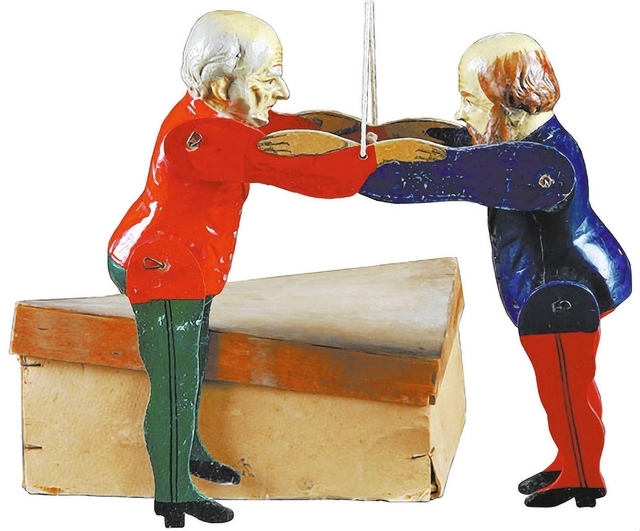Companies often toyed with political adversaries
Political fights among politicians are not new. Today, the rivalries are ridiculed in political cartoons and on TV sitcoms. In the past, political differences were shown in Staffordshire figures, slogans and drawings.
The rivalry in Britain in the last half of the 19th century between the prime ministers Benjamin Disraeli (1804-1881) and William Gladstone (1810-1898) was notable. Both men were skilled politicians, but they hated each other. The two men came from different backgrounds. Gladstone was a rich and deeply religious upper-middle-class man educated at Eton and Oxford. Disraeli never attended a university and was a wild youth who lived extravagantly. He wrote novels, accumulated debts and then married a rich widow.
Gladstone, a liberal (Whig), and Disraeli, a conservative, disagreed on both social and international policies. They called each other names, opposed each other in numerous campaigns and were able to defeat each other at times. The repeal of the Corn Laws, which lowered tariffs, the purchase of stock in the Suez Canal, the favor of Queen Victoria, and other major problems were part of their battles.
Political cartoons of the time often showed the two men fighting. There were even toys that pictured the men wrestling. Several versions of the toy have been sold through the years. In 2013, Jackson’s Auctions sold a pair of 8½-inch-high Gladstone and Disraeli figures in their original box for $180.
Q: My maple armchair is marked “A Genuine Cushman Colonial Creation made in Bennington, Vt.” The words are printed in several type styles inside an oval. How old is it?
A: H.T. Cushman (1844-1922) was an inventor who created things like the pencil eraser, ink eradicator and some early types of roller skates. He started a mail-order company and soon was making and selling things, including furniture. By 1899 he had incorporated his company and was making Mission furniture. Later he made smoking stands and maple breakfast-room sets.
Your chair probably is from one of his breakfast room sets. By the 1950s, the company was making birch furniture in the Colonial style. The company was later sold and closed in 1980.
Q: I have a red, white and blue metal sign that reads “Hudson, Service Station, Essex.” There’s a blue triangle on the sign that says “Hudson Super Six” and a red hexagon that reads “Essex Motor Cars.” The sign is 13 inches high and 27½ inches wide. What is it worth?
A: Hudson Motor Car Co. was founded in 1909. Its Super Six engine was introduced in 1916. The Essex was a less expensive Hudson car introduced in 1919 and made until 1932. Hudson merged with Nash in 1954 and became American Motors Corp.
Automobile-related advertising of all kinds is collected. Signs can sell for hundreds or even thousands of dollars, depending on age, rarity and condition. Your sign, from the 1920s, could sell for $500 or more.
Q: I have a McCoy cookie jar that belonged to my grandmother. It’s shaped like an apple and is yellow with red highlights. The lid has a stem and leaf on the top. I’d like to know how old it is and what it might be worth.
A: McCoy pottery was made in Roseville, Ohio. The company made cookie jars from about 1940 until the pottery closed in 1990. Its apple cookie jar was made from about 1950 to 1964. It was also made in turquoise, a rare color that sells for more.
The value of your apple cookie jar is about $100.
Q: I have a late 19th-century bronzed spelter statue of Hernani. It’s just under 2 feet tall. He is holding a sword, dagger and horn, and is in excellent shape. Value?
A: Hernani was the title character in a play by Victor Hugo. It opened in Paris in 1830 and is set in the Spanish court of 1519. Bronzed spelter statues of Hugo’s fictional characters were popular in the late 19th century. One the size of yours sold for $140 earlier this year.
Q: I have a picture postcard showing the original photograph of President Franklin Roosevelt signing the Social Security Act on Aug. 14, 1935. It’s signed by James Roosevelt, FDR’s oldest son. Does it have any value?
A: Thousands of copies of this photograph were sent out by the National Committee to Preserve Social Security and Medicare in a mass mailing in 1985, the 50th anniversary of the signing of the Social Security Act into law. The committee was founded by James Roosevelt in 1982. It advocated raising Social Security benefits for the “notch” babies, a term coined by Ann Landers for those born from 1917 to 1921 who received lower benefits than people born from 1910 to 1916 because of a change in the way cost-of-living adjustments were determined.
The committee still exists and works to prevent cuts to Social Security and Medicare. The mailing was part of a fundraising effort by the committee. The same photograph also was included in a 1990 mailing. So, your picture postcard is a common one and not of much interest to collectors.
Tip: Don’t leave anything inside old books — especially pressed flowers, paper clips, newspapers or sticky notes. They will cause stains, crease pages and do other damage.
CURRENT PRICES
Current prices are recorded from antiques shows, flea markets, sales and auctions throughout the United States. Prices vary in different locations because of local economic conditions.
Hair clip, bow, pearls, gem center, back comb, Yves Saint Laurent, $60.
Political souvenir plate, William Howard Taft and running mate James Sherman, border of past Republican presidential candidates, tin, 1908, 9½ inches, $110.
Tramp art watch hutch, house shape, round opening, c. 1890, 15 inches, $120.
Leaf pin, silver, berry design, Kalo, 2½ inches, $220.
Dominoes set, ebony, bone, box, c. 1850, 7¾ inches, 28 pieces, $265.
Santo monk figure, wood, white glass eyes, gilt rope sash, brown robe, hands raised, Spain, c. 1765, 17 by 9 inches, $275.
Pewter box, lid, oval, inset green stone, Liberty &Co., 3½ by 2 inches, $315.
Bench, wood frame, black paint, rush seat, Italy, 1950s, 18 by 18 inches, pair, $500.
Quilt, appliqued, golden eagle on shield, stars, red, blue, white, c. 1950, 91 by 76 inches, $850.
Palmist and clairvoyant trade sign, black, white paint, 50 inches, $5,040.
Terry Kovel’s column is syndicated by King Features. Write to: Kovels, (Las Vegas Review-Journal), King Features Syndicate, 300 W. 57th St., New York, NY 10019.




























